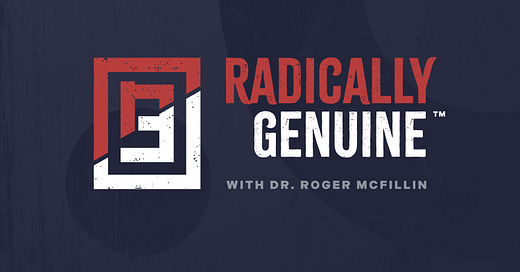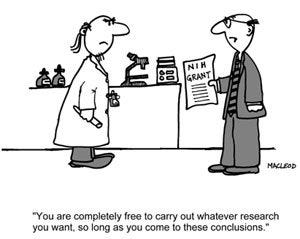When we engage in conversations with our physicians or absorb information from seemingly reliable news sources, we naturally expect that these insights rest upon a robust bedrock of empirical evidence. The recommendations and prescriptions offered by our medical professionals are often delivered with a resolute sense of certainty.
Whether we're pondering the merits of cutting down on saturated fat in our diets, considering blood pressure medications, making informed choices about childhood vaccinations, evaluating cholesterol levels as predictors of heart disease, reflecting on the use of antidepressants during tough emotional times, or navigating treatment paths for cancer, our confidence in these decisions is based on the assumption these medical recommendations are supported by decades of evidence.
Game over. The science is clear.
You have my trust.
The dynamics of this unwavering trust became particularly evident during the tumultuous course of the COVID-19 pandemic. As the public health authorities and their chosen medical experts graced the screens of American televisions, many assumed that their presentations were underpinned by the most impeccable evidence available. Their impressive array of professional credentials further cemented the notion of their reliability.
"Trust the science," they emphasized.
To hold an opposing viewpoint was seemingly tantamount to disconnecting from reality itself. Only a paranoid conspiracy theorist could challenge science. A label reserved for those presumed to possess lesser education, incapable of grappling with the intricate nuances of scientific discourse, instead preferring to lean on superstition and religious beliefs.
Embedded in this portrayal was the suggestion that these individuals, due to their lack of understanding, could inadvertently jeopardize our well-being. They were deemed risky. This viewpoint was further linked to associations with right-wing white nationalist agendas determined to seize control of the government. Consequently, they became labeled as a primary threat, a new public enemy.
Trust the "experts"! Refrain from questioning, abstain from delving into scientific literature, and resist posing critical inquiries. After all, you lack their specialized knowledge.
Wear your mask!
Stay 6 feet away!
Take the vaccine!
You have no rights when it comes to OUR health!
The concept of medical freedom, once valued, began to appear antiquated and incongruent with the gravity of a pandemic as it started to pose risks to individual health.
In such a climate, even a hint of questioning the sanctity of medical authority and the revered realm of SCIENCE became synonymous with disseminating misinformation. This sentiment provided the rationale for stringent censorship measures. To the extent that even scientists embarking on the path of scientific inquiry found themselves treading on precarious ground, their professional licenses seemingly at stake.
Facts faded as fear took precedence. Despite a near 100% recovery rate for healthy individuals, the imperative remained: you must receive the vaccine regardless. Even if you've already contracted the virus, it seemingly held little relevance.
Trust the Science?
Dr. John Ioannidis, a Stanford professor and medical researcher, has made it his life's work to challenge his fellow peers by uncovering flawed scientific practices. He's known as a meta-researcher, and his expertise has propelled him to the forefront as a leading authority on the credibility of medical research globally. He has consistently demonstrated that a significant portion of the findings drawn by biomedical researchers in their published studies tend to be misleading, overstated, and frequently outright incorrect.
To what extent is the problem?
He asserts as much as 90 percent of the published medical information that doctors rely on is flawed.
Surprisingly, despite such claims, he avoids being dismissed as a conspiracy theorist and remains widely respected within the U.S. medical community. His work is extensively featured in top-tier journals, affirming his influence.
He holds unparalleled authority in assessing medical research credibility, driven by extensive research interests and meticulous statistical approaches. Personally, his research in psychiatric literature has shaped my view on the questionable pseudoscience surrounding psychiatric drugs paraded as SCIENCE.
During the COVID pandemic, he remains a dependable figure in evaluating what was touted as scientific and revealing the flaws. He openly asserts that the published scientific literature is so flawed and riddled with conflict of interests that doctors are relying upon an illusion of scientific consensus to drive decision making.
According to Dr. Ioannidis, the Medical Misinformation Mess comprises four key problems:
Much published medical research is not reliable or is of uncertain reliability, offers no benefit to patients, or is not useful to decision makers.
Most healthcare professionals are not aware of this problem.
Even if they are aware of this problem, most healthcare professionals lack the skills necessary to evaluate the reliability and usefulness of medical evidence.
Patients and families frequently lack relevant, accurate medical evidence and skilled guidance at the time of medical decision-making.
Could it be that those challenging COVID vaccine and mask mandates weren't mere conspiracy theorists? Perhaps skeptics of widespread psychiatric drug use aren't anti-psychiatry zealots, but rational questioners. Is there a chance that global scientists opposing invasive health measures held crucial information, while public health experts turned a blind eye?
The For Profit Science Model
I argue that the majority of the general public, along with many physicians, remain oblivious to the corporate interests steering, molding, and governing scientific narratives. A recent study spotlighted eight corporate sectors—alcohol, chemicals and manufacturing, extractive industries, food and beverages, fossil fuels, gambling, pharmaceuticals and medical technologies, and tobacco—as active players shaping science and its integration into policies and practices. These corporations employed five overarching strategies to wield influence over both science itself and its application in policy and real-world contexts.
Strategy 1. Influence the conduct and publication of science to skew evidence bases in industry’s favor
Evidence that portrays industries in an unfavorable light—highlighting potential harm or raising doubts about the effectiveness or necessity of their products and practices, or endorsing interventions and policies that might impact their profits—is systematically downplayed. Conversely, evidence that serves industry interests—by obscuring potential harm, proposing alternative explanations for negative outcomes (often targeting individuals rather than the corporations), extolling the supposed benefits of their offerings, or fostering skepticism about interventions and policies that could dent profits—is deliberately magnified.
Industries proactively strive to ensure that research aligned with their objectives gains substantial representation in the body of evidence. To artificially amplify the visibility of their research in peer-reviewed publications, some industries resort to publishing the same findings repeatedly. However, when publicly conducted research produces outcomes contrary to industry preferences, tactics are deployed to exert control over access to such data. For instance, the pharmaceutical sector might employ legal threats against researchers who attempt to publish unfavorable results.
Strategy 2. Influence the interpretation of science to undermine unfavorable science and create a distorted picture of the evidence base
These strategies collectively function to diminish the perceived credibility of unfavorable scientific findings while amplifying the perceived credibility of favorable ones. This manipulation skews public and expert perceptions of science, scientists, and scientific organizations.
An additional tactic employed by industries involves obtaining and reanalyzing raw data from unfavorable studies to undercut their impact. This strategy materializes through exerting pressure and legal actions against researchers, as well as advocating for data access legislation that facilitates industry's access to publicly-funded research data.
By attacking and misrepresenting the evidence base, industries aim to challenge unfavorable science that implicates their products or practices in causing harm. On the surface, critiques of the methods used in such studies may appear as legitimate scientific arguments. However, these criticisms often adhere to industry-friendly criteria and are wielded in contradictory ways, contingent on the context. Furthermore, the strategy of targeting scientists and scientific bodies is utilized to weaken opposition and sow doubt.
Strategy 3. Influence the reach of science to create an “echo chamber” for industry’s scientific messaging
After successfully crafting a distorted evidence base and twisting interpretations of that base, industries then embark on expanding the influence of their favored scientific narratives. Legal tactics are employed to shield their unfavorable research from exposure or accessibility. To magnify the dissemination of scientific messages that align with their objectives, corporations enlist an array of "friendly" voices as messengers. This diversely composed lineup encompasses front groups engineered by industry, third-party entities like think tanks, professional associations, and PR agencies, as well as individuals positioned as "experts" and allied industries. This multifaceted approach serves to amplify scientific messages while distancing them from their industry origins.
Strategy 4. Create industry-friendly policymaking environments which shape the use of science in policy decision-making in industry’s favor
Corporations have strived to institutionalize the integration of industry-friendly scientific criteria into regulatory processes. A notable instance is their financial support of prominent medical associations, coupled with the formulation of "scientific protocols" that direct doctors' clinical choices. Medical practitioners who deviate from these guidelines risk jeopardizing their medical licenses, especially if outcomes turn unfavorable. Additionally, corporations have adeptly obtained and employed policy reforms that enhance dependence on and offer a channel for science that serves industry interests.
Strategy 5. Manufacture trust in industry and its scientific messaging
Lastly, industries employ two overarching strategies that serve as the foundation for all the aforementioned macro-level approaches. They achieve this either by crafting an image of industry credibility or by obscuring industry participation in scientific endeavors. This dual tactic functions to bolster the credibility of industry's scientific contributions and also bolsters the legitimacy of their directives on how science should be perceived and applied.
They achieve this by providing financial support to academics—through grants, honoraria, awards, and consulting fees—as well as extending assistance to students via generous studentships. This strategic approach not only establishes a corporate presence within academia but also fosters a sense of reliance on industry funding. Industry actively promotes this funding and the resulting ties to academia as evidence of its commitment to uncovering the "truth" about potential product hazards.
In certain instances, industries collaborate openly with organizations beyond university settings to bolster their credibility. Noteworthy examples include Coca-Cola assuming a corporate partnership with the professional body, The American Dietetic Association, and the gambling industry making voluntary contributions to the funding entity, The Responsible Gambling Trust. The tobacco industry, for instance, has adeptly employed third-party entities to obscure its influence on science and its application, exemplified by the Center for Indoor Air Research.
Fool Me Once, Shame on You; Fool Me Twice, Shame On Me
The well-known adage "Fool me once, shame on me; fool me twice, shame on you" takes on a striking relevance in the context of stumbling COVID policies, especially when intertwined with industry conflicts of interest. At the outset, people might have understood the challenges faced by authorities dealing with an unprecedented crisis. However, as time passed, revealing flaws in their strategies, the responsibility shifted. What was once seen as a collective willingness to trust now places a duty on those in power to correct their missteps.
Yet, we remain on the doorstep of potential future mask mandates, forced vaccinations and other attempts of government to misuse fraudulent science for authoritarian control. As citizens, this saying urges us not only to question authority but also to consider civil disobedience when necessary. It prompts us to refuse repeated deception despite evidence and to demand accountability for decisions that affect lives.
With the veil lifted on the deception within medical research, the onus rests on us to strip medical authorities of their positions of influence. The shift away from the dominant allopathic medical framework, manipulated by industry, can only occur when we collectively reject its fallacies and seize authority over our well-being.
The more our health falters, the more we find ourselves reliant on their products. This dependency enriches them and amplifies their power.
RESIST






Did your recent convo with Adrian Gaty partially inspire this article? Amazing conversation. Love the conversations surrounding John Ioannidis’ work - brilliant human being.